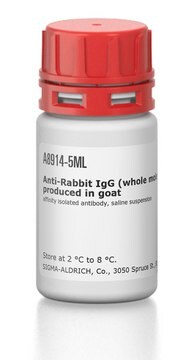A6531
Anti-Mouse IgG (whole molecule)−Agarose antibody produced in goat
affinity isolated antibody, suspension
About This Item
Productos recomendados
biological source
goat
Quality Level
conjugate
agarose conjugate
antibody form
affinity isolated antibody
antibody product type
secondary antibodies
clone
polyclonal
form
suspension
species reactivity
mouse
extent of labeling
≥5 mg per mL
technique(s)
Ouchterlony double diffusion: suitable
immunoprecipitation (IP): suitable
matrix
Cross-linked 4% beaded agarose
matrix activation
cyanogen bromide
matrix spacer
1 atom
capacity
0.4 mg/mL, resin binding capacity (mouse IgG)
storage temp.
2-8°C
target post-translational modification
unmodified
General description
Immunogen
Application
Chromatin immunoprecipitation (1 paper)
Immunoprecipitation (1 paper)
Biochem/physiol Actions
Physical form
Disclaimer
¿No encuentra el producto adecuado?
Pruebe nuestro Herramienta de selección de productos.
Storage Class
10 - Combustible liquids
wgk_germany
WGK 3
Elija entre una de las versiones más recientes:
Certificados de análisis (COA)
¿No ve la versión correcta?
Si necesita una versión concreta, puede buscar un certificado específico por el número de lote.
¿Ya tiene este producto?
Encuentre la documentación para los productos que ha comprado recientemente en la Biblioteca de documentos.
Los clientes también vieron
Nuestro equipo de científicos tiene experiencia en todas las áreas de investigación: Ciencias de la vida, Ciencia de los materiales, Síntesis química, Cromatografía, Analítica y muchas otras.
Póngase en contacto con el Servicio técnico











